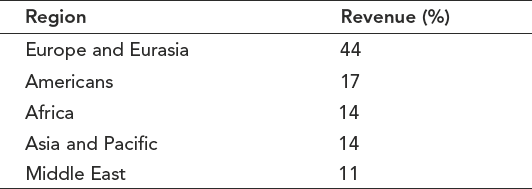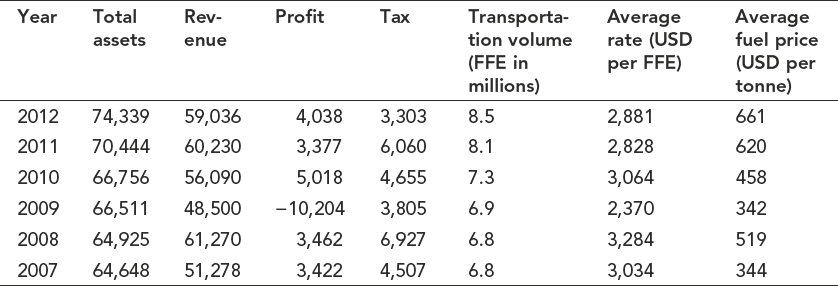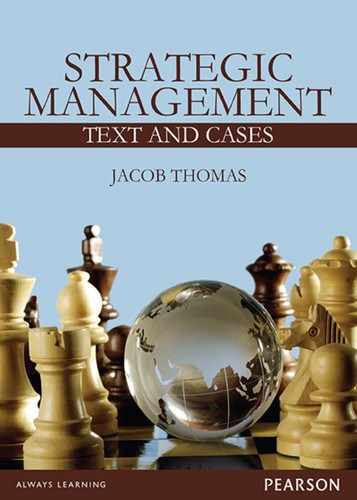CASE STUDY 1
MAERSK A SUSTAINABILITY COCKTAIL FOR SUPERIOR PERFORMANCE
Vladimir Putin is meeting the South Korean Leader Park Geun-hye, the first women President. This news surcharges the room of the group CEO Nils S. Andersen of Maersk at Esplanaden 50 in the Danish City of Copenhagen. Marersk has given order for 20 Triple E class ships at a cost of USD 185 million each to the DSME shipyard (Daewoo Ship Building and Marine Engineering), the second largest ship maker in the world located in Geoje Island at Okpo in South Korea—the global capital of ship building. AP Moller Maersk A/s has 76,000 shareholders and 1,21,000 employees in 130 countries. The CEO is obviously restless as his responsibility is enormous since Maersk group is a collection of 14 companies operating within two main industries shipping and energy with four core businesses: Maersk Line, APM Terminals, Maersk oil, and Maersk drilling. The revenue earned in 2012 is USD 59 billion based on its strengths of size and global reach, talented employees, and the drive to innovate. The passion to innovate led to the big decision of Triple E class vessels, and if this strategy of economies of scale in transportation fails, then the group as a whole will sink.
A railway line (referred as Iron Silk Road) connecting the consumption centres in Europe and the manufacturing hubs in China and Korea through Russia is a pet project of the Russian Leader for discussion in the meeting on 13, November, 2013; in Seoul. The cargo from Korea or China would reach the European cities in one-third time by rail than by ships and time is a factor of competitive advantage for companies.
As naming ceremony is a tradition with Maersk since 1906, the group CEO rang up Maersk Line CEO Soren Skou, who organized the naming ceremony of its first Triple E series of 18,000 TEU (twenty-foot container equivalent units) capacity at Okpo on June 14, 2013. The ship was named ‘Maersk Mc Kinney Moller’ by the youngest daughter Ane Maersk Mc Kinney Uggla by giving it her late father’s name, who passed away at the age of 98 in April 2012. The second vessel was named as Peter Maersk. The ceremony launched the largest ship in the world that emits 50% less CO2 per container than the current average in the Europe–Asia route.
Timeline of Maersk
The company, which was founded more than 100 years back, has steadily grown to become the largest container transport company in the world, whereas the ownership reached the third generation of the founder and the public.
| 1904: | Founded by AP Moller and his father Capt. Peter Maersk Moller, in Denmark |
| 1919: | Expanded to USA |
| 1928: | Maersk Line was founded and acquired the first five tankers |
| 1962: | Establishment of DUC, starting oil and gas business |
| 1965: | Maersk Mc-Kinney Moller became CEO after his father passed away |
| 1972: | Maersk drilling was founded |
| 1975: | First container vessel |
| 2001: | APM terminal was founded |
| 2013: | Launch of Triple E, the largest and most energy efficient container ship |
The Triple E class, being built in South Korea, is the largest container ship with 400 m length, 23 knots (43 km/h) speed, 59 m (beam) breadth, dead weight of 1,65,000 tones that can carry 18,000 TEU. The objective is to reduce a considerable part of the price of a commodity that consumers pay for transportation by economy of scale in transportation and to link producers and consumers anywhere in the world with faster and safer transport of merchandise.
Responsible Business Practices
Through its 1,00,000 suppliers in over 100 countries, Maersk influences responsible business practices through its foundation of:
- Maersk group policies
- Core values
- Sustainability reporting
- Third party code of conduct
Wealth Creation and Wealth Distribution
Out of USD 55 billion the group transacts, 58% goes to its 1,00,000 suppliers in different parts of the world, and 12% to its 70,000 shareholders as dividends. It pays substantial amount as taxes almost equal to the profit. The profits are distributed as dividends and further investments in different countries, whereas taxes go to the welfare of the larger public. Dividend per share was USD 212 in 2012 which was 128 in 2007, with earnings per share of USD 856 in 2012 compared with USD 795 in 2007.
Sustainability Strategy
Maersk has a sustainability council for overall co-ordination and a biannual self-assessment of the business. There are four focus areas of the sustainability strategy with business integration as the overall focus.
- Health and safety
- Social responsibility
- Environment
- Responsible business practices
There are 25 key measures of integration and progress in each business which are scored on a scale of 0–3 on each measure. Then five dash boards are prepared to make progress of integration. Sustainability initiative is started by Maersk in 2007 with SSE Manual, followed by an HSSE Report in the next year. An environmental strategy is formulated in 2008 and the first group sustainability report is published in 2010. A group sustainability strategy is formulated in 2010 for 2010–2013 period.
Country-wise Focus
Maersk undertook a study in Brazil on how its national competitiveness can be improved by Maersk interventions. Enhancing coastal shipping using 40 ports of Brazil, in its long coastline of 7,500 km, and improving the operational efficiency of Port of Santos are two such initiatives. Extensive use of trucks increases transport costs 3–4 times, increases congestion on roads, and leads to unreliable transport times. The benefits to Brazilian society, at present, by transporting 4% of truck volume by coastal ships are as follows:
- Saving 4,100 road accidents per year
- Saving USD 200 million in road maintenance and medical costs
- Reducing 0.5 million tonnes of air emissions
Maersk plans to move 2.7 million TEU from roads to coastal shipping, corresponding to 800% increase in coastal transport volumes. This increase would benefit Brazil in the following ways:
- Saving 36,000 road accidents
- Saving 1,700 million in road accident-related medical costs
- Saving 125 million in road maintenance
- Reducing 4.4 million tonnes of CO2 emissions
Maersk observed that movement by ships is more economical than trucks when the distances are more than 1,500 km and the origin and destination are within 200 km radius of a port. Another initiative is to train 4,000 Brazilians each year by 2016.
Environmental Risks
Even though shipping has economic and environmental benefits over road transport, shipping also has some risks, albeit on a lower scale.
- Oil spills is the most important risk.
- CO2 emission (By making an investment of USD 10 million, to cut out the chartered ships turbo chargers to improve the efficiency of sailing at slow speeds, Maersk aims to save 31,000 tonnes of fuel and 9,60,000 tonnes of CO2 emission during 2012–2013.)
- Fuel consumption (Installing Maersk Line’s performance system and energy efficiency tracking in all the chartered vessels have saved 1,42,000 tonnes of fuel and 4,42,000 tonnes of CO2 emission during 2012.)
- NOx
- SOx
- Biodiversity
- Wastes
- Ballast water
- Tanker accidents
Sustainability Cocktail
The portfolio of initiatives in the sustainability strategy of Maresk includes the following:
- Diversity in employee strength and inclusion
- Best labour practices and global labour principles
- Tax payments
- CO2 emission reduction
- Stakeholder engagement
- Employee engagement
- Strategy and governance
- Materiality (which issues are most material to Maersk based on the factors of cost, revenue, compliance, and reputation. Maersk plots the issues on a materiality matrix based on the importance of each issue to the stake holders and to the business. Oil spills, energy consumption, process safety, Arctic activities, and CO2 emission are rated as very important both for the stakeholders and the business.)
- Safety
- Piracy
- Climate and environment
- Human rights
- Anti-corruption and whistle blowing
- Responsible procurement
In spite of the several initiatives, fatal accidents have been rising in recent years from 12 in 2010, 13 in 2011 to 17 in 2012. Women in leadership, in spite of diversity focus, is hovering around 8%–9% during the period 2010–2012. The number of suppliers registered in responsible procurement is 1,431 at the close of 2012 from among the 1,985 suppliers who approached Maersk.
Third Party Code of Conduct
Being a member of the UN global compact, AP Moller Maersk has published a third party code of conduct for their suppliers to implement the standards of this code. Third parties include contractors, joint venture partners, and suppliers. The revenue of Maersk is distributed geographically into all regions of the world as shown in the Table C1.1 and thus implementing the code has global impact.
Table C1.1 Revenue distribution of Maersk among geographies

The code of conduct emphasizes responsible business behaviour in an ethical and lawful manner. In addition, the code draws attention to anti-corruption policy, health and safety of employees, and adhering to national and local environmental laws and regulations.
Maersk Work Culture
Maersk actively promotes a culture rooted in its values of humbleness (humility), constant care, uprightness, reputation, and development of employees. The culture is skewed towards employee engagement to drive performance, than any other motive, by empowering employees, linking job performance with rewards, and leading by example. Other-orientation balanced with self-orientation is expressed in the principle of the employee taking responsibility for his or her own development and career progression while contributing to the development and career progression of colleagues.
Economic Performance
Maersk not only operates 600 container vessels but also operates 63 ports and terminals through its SBU, APM terminals. The entire supply chain from production of container, inland transport, storage, ocean freight, port operations, and terminal operations of containerized cargo remains the core business of Maersk group, generating more than 50% of its revenue.
Table C1.2 Revenue, profit and tax paid by Maersk during the last six years in USD million

There is a growth in assets of Maersk, even though the profit was declining. In spite of increase in fuel prices, Maersk could transport more volumes at cheaper rate for clients in recent years, as the data in Table C1.2 depicts.
Shift from Bulk Cargo to Containerized Cargo
In 1956, Malcolm Mc Lean refitted an oil tanker with steel frames on its deck to stack shipping containers. Modular units of uniform size as standardized containers came into shipping scene, thus reducing the cost of loading cargo onto a freight ship. Till then, stevedores used to pile cargo in sacks and crates of various sizes on the deck. Maersk came very late on the container shipping scene, as late as 1973 by building its first container ship. It bought Mc Lean’s Company and Sea–land to obviate the late entry and started a race in cargo transport. The core of its strategy was to offer its clients more sailings to more points and more container slots on each trip. It now operates in 100 routes, matching the client’s cargo volumes between each origin–destination ports of the client’s cargo. The opportunity to transport more containers per trip, thereby reducing the cost of transport per tonne of cargo by economy of scale, led to the idea of Triple E class vessels.
Questions
- Critically assess the effectiveness of the sustainability strategy of Maersk in combating climate change.
- Elucidate the critical risks to the sustainability of Maersk’s strategic intent while ordering 20 Triple E class container ships.
- ‘Organizational culture shapes the strategy of a firm’. Does this statement or its opposite ‘Strategy shapes the organizational culture’ hold good for Maersk.
